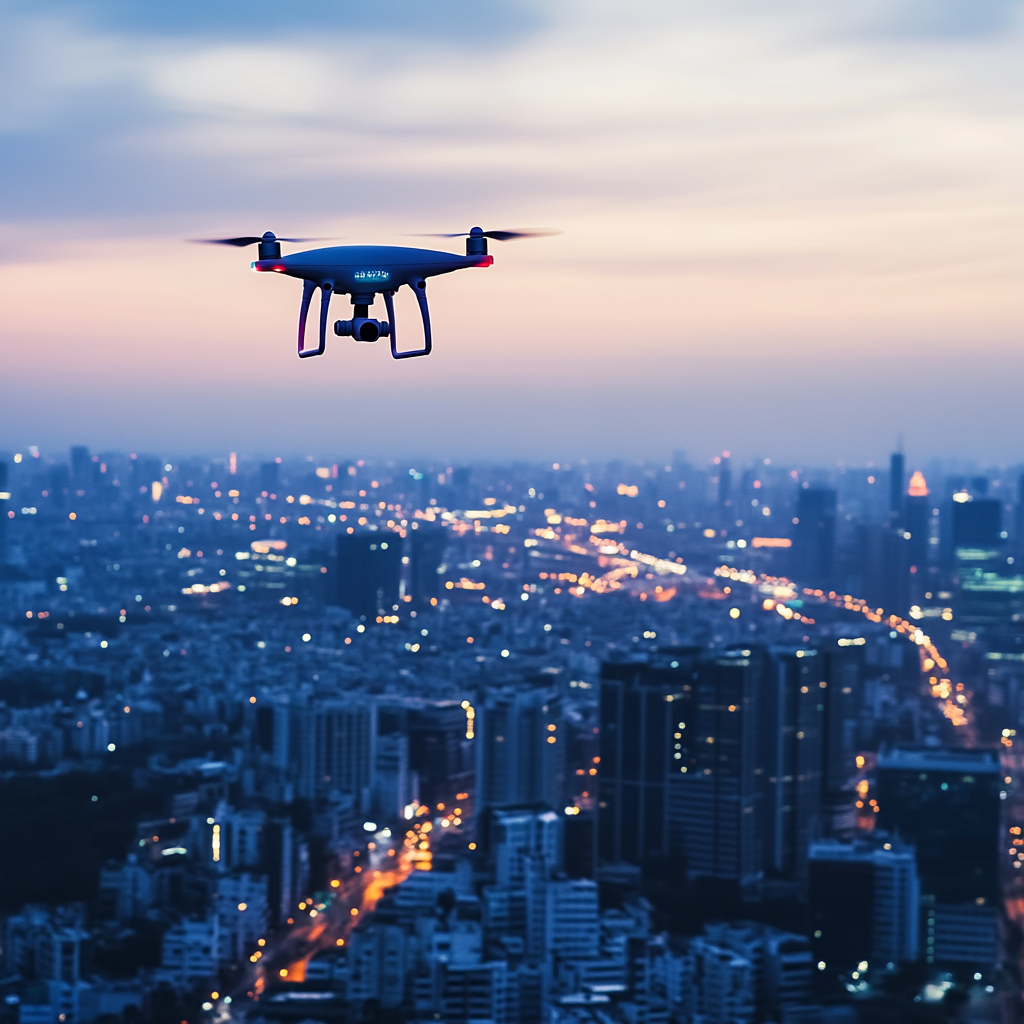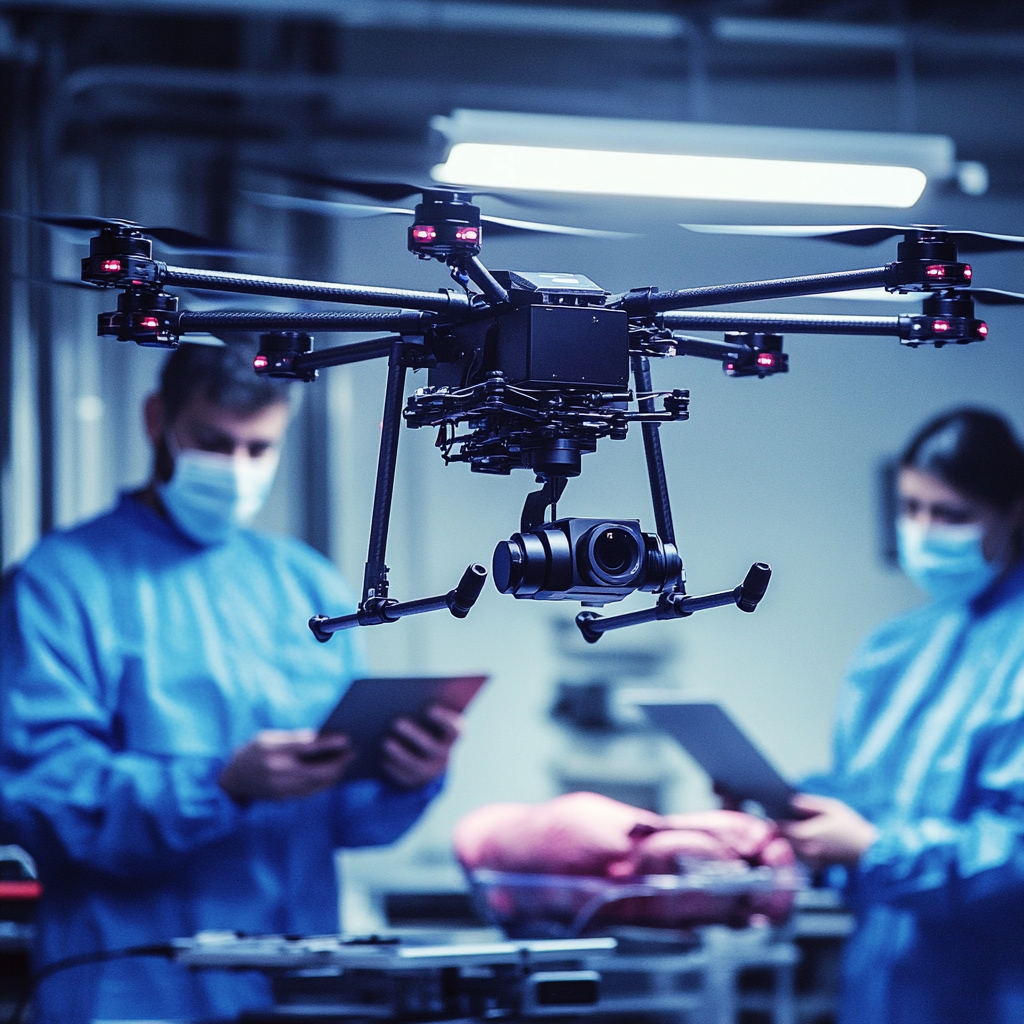The Future of Drone Technology in Organ Transport: A Game Changer for Healthcare Logistics
The future of drone technology in organ transport promises faster and more reliable deliveries. This article explores how these advancements can overcome current limitations and potentially save more lives.
Key Takeaways
Drone technology has the potential to revolutionize organ transport by reducing cold ischemia times, improving organ viability, and addressing logistical challenges in the healthcare system.
Current limitations include regulatory restrictions from the FAA and operational challenges that hinder long-distance deliveries, necessitating further innovation and education in drone use for medical transport.
Major companies and innovators are advancing the integration of drones in organ transport, with emerging technologies promising to enhance the efficiency and reliability of healthcare logistics.
Understanding Drone Technology in Organ Transport

To appreciate the revolutionary impact of drone technology in organ transport, understanding the basics is crucial. Drones, also known as unmanned aerial vehicles (UAVs), are being explored to transport blood samples and organs, offering a potential solution to address the long-standing challenges of organ transportation. The demand for innovative transport solutions is driven by a critical shortage of donor organs, which affects transplantation waiting lists in the USA.
Organ transportation through drones opens new avenues for improving procurement practices. Unlike traditional methods, drones can deliver organs faster and more efficiently, directly addressing logistical challenges faced by the current transportation system. The technology’s ability to transport human organs swiftly could be a game-changer in the field of organ transplants.
Definition and Specifications
Organ transportation drones are specifically designed to deliver vital organs such as hearts, kidneys, and livers. These drones vary in size, with the smallest ones starting at 30 cm and larger models weighing up to 4.5 tons. The maximum payload capacity of these drones is 180 kg, allowing them to transport various organs effectively. Transporting organs with MGM Healthcare’s drone can cover up to 20 kilometers, while Zipline’s drones are known for high speeds and long-distance capabilities.
Next-generation drones with advanced features such as improved payload capacities and enhanced navigation systems are being developed, making them more suitable for transporting sensitive medical items. Some models can transport over 500 pounds across long distances, and the maximum peak velocity observed during drone transport is 67.6 km/h.
Current Limitations
Despite their potential, drones face significant challenges in organ transportation. Currently, drones primarily transport organs over short distances, making international deliveries impractical due to operational challenges. One of the major limitations is the Federal Aviation Administration (FAA) regulations mandate that drones operate within the pilot’s line of sight, impacting their ability to transport organs over longer distances.
The regulatory environment surrounding drone use, especially for organ transport, is complex and evolving. Current FAA rules pose significant challenges, including restrictions on flight altitude and distance. Additionally, logistical issues related to timing and piloting accuracy during critical delivery periods further complicate the use of drones for organ transport.
The Importance of Drones for Organ Transportation

Drones have immense significance in organ transportation. The current state of organ transportation in the US healthcare system is a complex network of non-specialized couriers that have not significantly advanced in over 60 years. This outdated system contributes to the logistical challenges that result in as many as 3,500 organs being discarded yearly in the USA. Drones offer a faster, more efficient solution that directly addresses these challenges, potentially saving thousands of lives.
Drones enhance the efficiency and speed of organ transportation, which is critical for successful transplants. The success of organ transplantation depends on crucial factors such as organ preservation and minimizing ischemic tissue damage. Reducing transportation time and maintaining optimal conditions with drones can significantly improve transplant outcomes.
Cold Ischemia Time Reduction
A key benefit of using drones for organ transport is the reduction in cold ischemia time. Cold ischemia time refers to the period during which a donated organ is kept at a cold temperature after being removed from the organ donor but before being transplanted into the recipient. Reducing cold ischemia time is critical for successful transplants. Wireless biosensors paired with GPS provide immediate updates on the organ’s status during flight, ensuring timely delivery.
In 2019, the first transplant of a human organ delivered by drone was successfully completed, showcasing the potential of this technology. MissionGO conducted test flights in Las Vegas, successfully transporting corneas and a human organ via drones, demonstrating the feasibility and effectiveness of drone organ delivery.
A significant 76.4% of surgeons believe that reducing cold ischemia time to under eight hours could increase organ acceptance rates, highlighting the importance of this technological advancement.
Improved Organ Viability
Drones can significantly improve donor organ viability by maintaining stable temperatures during transport. By shortening cold ischemia times, drones enhance organ viability and increase the number of successful transplants. Additionally, drone transportation minimizes harmful vibrations that can compromise the integrity of the transported organs.
Advanced technologies in organ transport drones, such as real-time monitoring systems, ensure that organs are delivered in optimal conditions, preventing viability loss. Systems like HOMAL continuously track critical parameters such as temperature, humidity, and pressure during transport. These systems alert medical teams instantly if environmental conditions deviate from safe parameters, enabling timely interventions to preserve organ quality.
Did you know that you can get from Manhattan to JFK in under 5 minutes without driving?
Blade offers seamless helicopter transfers from our West 30th Street Lounge in Manhattan to JFK Airport in just 5 minutes from $195 per seat.
Skip the traffic and ditch the stress with Blade's year-round airport service.

Leading Companies in Drone Organ Transport

Several companies are at the forefront of using drones to enhance the organ transplant supply chain. MediGO and MissionGO are notable examples, leveraging drone technology to optimize logistics in organ transportation. These companies’ innovative solutions streamline the organ delivery process, making it faster and more reliable than traditional methods that depend on commercial flights.
The efforts of these companies in organ transportation through drones are revolutionizing the field. By optimizing logistics and ensuring timely delivery, they address significant challenges and improve procurement practices.
Notable Innovators
Joseph R. Scalea is a key figure in advancing drone technology for organ transport. He has co-founded startups focusing on this innovation, driving the field forward. Companies like Zipline and Matternet are also actively developing drone technologies specifically for organ transport, showcasing their commitment to improving healthcare logistics.
These innovators are not only enhancing the capabilities of drones but also setting new standards in the field. Their work is paving the way for more efficient and reliable organ transport, ultimately saving more lives.
Case Studies
Case studies provide valuable insights into the effectiveness of drones in organ transport. Historical Eurotransplant data and BIG organ transplantation data provide essential insights for organ transportation analysis. Additionally, German and Austrian hospital databases contribute important information to this field. For instance, 80% of organ transport trips in Austria occur within a distance of 150 km, demonstrating the practicality of drone deliveries for short distances.
Project CAELUS is testing a national drone delivery network in Scotland to transport essential medical supplies, including organs, showcasing the effective use of drone technology in healthcare. These case studies highlight the potential for drones to revolutionize organ transport and improve healthcare outcomes.
Surgeons' Perspectives on Drone Technology
Surgeons’ perspectives on drone technology are crucial for understanding the potential and challenges of this innovation. Many transplant professionals recognize the existing challenges of the traditional organ delivery system and the future potential that drone technology holds. However, they also express concerns about team safety during transport and potential timing issues associated with drone deliveries.
Addressing surgeons’ insights and concerns is vital for successfully implementing drone technology in organ transport. Their feedback helps refine the technology to meet the needs of healthcare professionals and patients.
Survey Insights
A survey conducted among transplant surgeons provides valuable insights into their perspectives on drone technology. The majority of surveyed surgeons, 92.7%, believe that drones could assist in improving organ transport. However, most rated their knowledge of drone technology as average or below average, indicating a need for more education and training in this area.
Interestingly, 89.1% of surgeons believe it is possible to move an organ over three miles using drones. This optimism is tempered by concerns about the technology’s impact on patient decisions and knowledge about current transportation methods. These insights highlight the importance of addressing surgeons’ concerns and improving their familiarity with drone technology.
Addressing Concerns
Surgeons have expressed various concerns about the use of drones for organ transport. Anxiety and fear related to this new technology are common, with 23% of surgeons reporting feeling fearful about its use. Additionally, a significant proportion, 34.5%, reported feeling nervous about the use of civilian drones.
Continuous visibility during transport allows for better decision-making by medical teams, contributing to higher transplant success rates. Education, training, and robust monitoring systems can help alleviate surgeons’ fears and ensure the successful adoption of drone technology in organ transport.
Technological Innovations and Real-Time Monitoring

Technological innovations, particularly real-time monitoring systems, play a crucial role in the success of drone organ transport. Devices like HOMAL track critical parameters such as temperature, pressure, and location during transport. These systems ensure the integrity of the organ being transported, reducing the risk of degradation.
Real-time monitoring maintains stable conditions, enhancing organ quality throughout transport. This technological advancement is a significant step forward in improving organ procurement practices and ensuring successful transplants.
Real-Time Monitoring Systems
Real-time monitoring systems like HOMAL track essential metrics such as temperature, pressure, and location to ensure organ safety during transport. These novel devices measure critical parameters, providing continuous data that medical teams can use to monitor the organ’s condition.
These systems are vital for ensuring the safety and viability of organs during transport. Maintaining optimal conditions with real-time monitoring systems significantly enhances transplant success rates.
Impact on Organ Quality
Real-time monitoring systems have a profound impact on organ quality and viability. Maintaining ideal conditions and reducing the risk of post-transplant complications, these systems enhance organ viability. They enable immediate corrective actions if environmental parameters deviate, ensuring that organs are kept in optimal conditions throughout transport.
Maintaining stable temperatures below 5°C during transport is crucial for preserving organ quality. Real-time monitoring systems play a critical role in achieving this, ultimately improving the outcomes of organ transplants.
Regulatory and Logistical Challenges
Navigating the regulatory and logistical challenges of drone organ transport is crucial for its successful implementation. The regulatory framework for drone operation involves compliance with strict safety protocols set by the Federal Aviation Administration (FAA). Drones must navigate regulatory challenges, including airspace authorizations and operational certifications. These regulations ensure safe operations and facilitate innovative drone use in organ transportation.
However, logistical challenges such as efficient coordination and timing issues must also be addressed to ensure timely and safe delivery to transport donated organs.
Federal Aviation Administration Regulations
The Federal Aviation Administration (FAA) establishes regulatory frameworks governing drone operations for medical deliveries. FAA’s Part 135 certification is necessary for commercial drone operations transporting medical supplies, ensuring both safety and compliance. Programs like the UAS Integration Pilot Program have been crucial in proving the feasibility of drone deliveries within regulatory frameworks.
These regulations not only ensure safe operations but also facilitate the innovative use of drones in organ transportation. Overcoming these regulatory challenges is essential for the widespread adoption of drone technology in healthcare logistics.
Overcoming Logistical Barriers
Logistical challenges in exploring organ transportation require efficient coordination to ensure timely and safe delivery of organs. Coordinating with organ procurement organizations is crucial for streamlining the organ recovery, organ shipment, and transportation processes. Collaboration with healthcare facilities is essential to ensure readiness for organ reception and transplant procedures upon arrival, especially with the Texas Organ Sharing Alliance.
Effective data management enhances visibility and communication, facilitating better logistical operations. Overcoming these logistical barriers is key to improving the efficiency and reliability of drone organ transport.
Did you know that you can get from Manhattan to JFK in under 5 minutes without driving?
Blade offers seamless helicopter transfers from our West 30th Street Lounge in Manhattan to JFK Airport in just 5 minutes from $195 per seat.
Skip the traffic and ditch the stress with Blade's year-round airport service.

Future Prospects and Potential Developments

The future prospects of drone organ transport are promising, with significant developments on the horizon. The healthcare drone sector experienced a remarkable growth of 30% in 2020 and is projected to reach $1.5 billion by 2028. The integration of electric drones in organ transport is expected to reduce operational costs and improve accessibility compared to traditional aircraft.
Driven by the need for efficient transport solutions, the integration of drone technology is expected to significantly lower transportation costs for medical supplies, including organs, by providing quicker and more efficient delivery solutions.
Emerging Technologies
Emerging technologies in drone transport are set to revolutionize the field. Autonomous drones are being developed to transport organs without the need for a pilot, potentially streamlining logistics further. These advancements could lead to reduced operational delays and faster delivery times for critical organ transports.
Autonomous drones could significantly improve the efficiency of healthcare logistics. These technologies represent a significant step forward in overcoming the challenges faced by the current transportation system.
Expanding Applications
Drone applications in healthcare go beyond organ transport. Drones are increasingly being recognized for their potential to deliver essential medical supplies such as vaccines and medications rapidly to remote locations. In addition to organ transport, drones can be used for timely transportation of blood samples, improving turnaround times for critical results.
Drones can also facilitate emergency medical deliveries, bringing urgent supplies to disaster-stricken areas or regions with limited medical access, ensuring swift assistance. Successfully implemented drone delivery systems in countries like Rwanda have shown how drones can enhance healthcare logistics by reducing the time it takes to deliver essential medical supplies.
The expansion of drone applications holds promising implications for healthcare logistics, enhancing efficiency and accessibility in medical care across various regions.
Bottom Line: The Future of Drone Technology in Organ Transport: A Game Changer for Healthcare Logistics
The integration of drone technology in organ transport represents a significant leap forward in healthcare logistics. By reducing cold ischemia time, improving organ viability, and streamlining the delivery process, drones offer a promising solution to the long-standing challenges of organ transportation. Leading companies like MediGO and MissionGO, along with notable innovators, are at the forefront of this technological revolution.
Despite regulatory and logistical challenges, the future prospects of drone organ transport are bright. With continued advancements in technology and regulatory frameworks, drones have the potential to transform organ transplantation and save countless lives. Embracing this innovation can lead to more efficient and reliable healthcare logistics, ultimately improving patient outcomes and expanding access to life-saving treatments.
FAQs about The Future of Drone Technology in Organ Transport
How do drones improve organ transportation?
Drones significantly enhance organ transportation by minimizing cold ischemia time, maintaining optimal temperatures, and reducing harmful vibrations, ultimately leading to improved organ viability and higher success rates in transplants.
What are the current limitations of using drones for organ transport?
Current limitations of using drones for organ transport are mainly short transport distances, regulatory constraints requiring operation within the pilot's line of sight, and challenges related to timing and piloting precision during critical delivery periods.
Which companies are leading the way in drone organ transport?
MediGO, MissionGO, Zipline, and Matternet are at the forefront of drone organ transport, focusing on improving logistics for timely and efficient organ delivery. These companies are paving the way for advancements in this critical area of healthcare.
How do real-time monitoring systems benefit drone organ transport?
Real-time monitoring systems enhance drone organ transport by tracking essential parameters like temperature and location, ensuring the integrity and viability of the organ. This leads to improved outcomes for organ recipients.
What are the future prospects of drone organ transport?
The future of drone organ transport is promising, with advancements in autonomous technology and cost reduction poised to enhance the delivery of organs and vital medical supplies to remote areas and during emergencies. This innovation could significantly improve organ transplant logistics and save lives.
Disclaimer:
Please be aware that the content on this page has been generated by using artificial intelligence language models and may contain errors, inconsistencies, or outdated information. It is provided as-is without any warranties or guarantees of accuracy. We strongly recommend using this content as a starting point for further research. We disclaim any liability for damages or losses resulting from the use or reliance on this content.